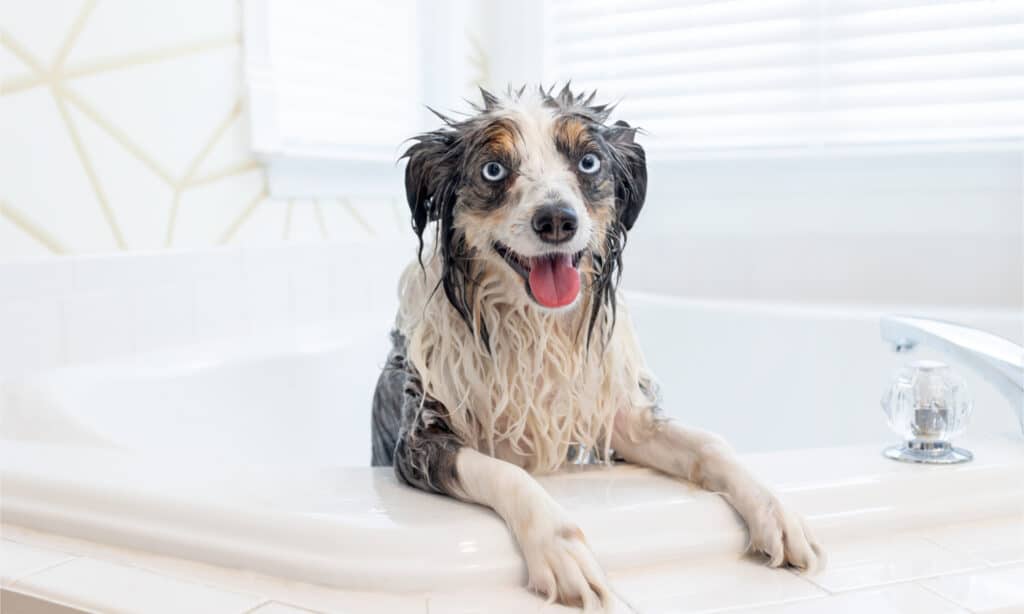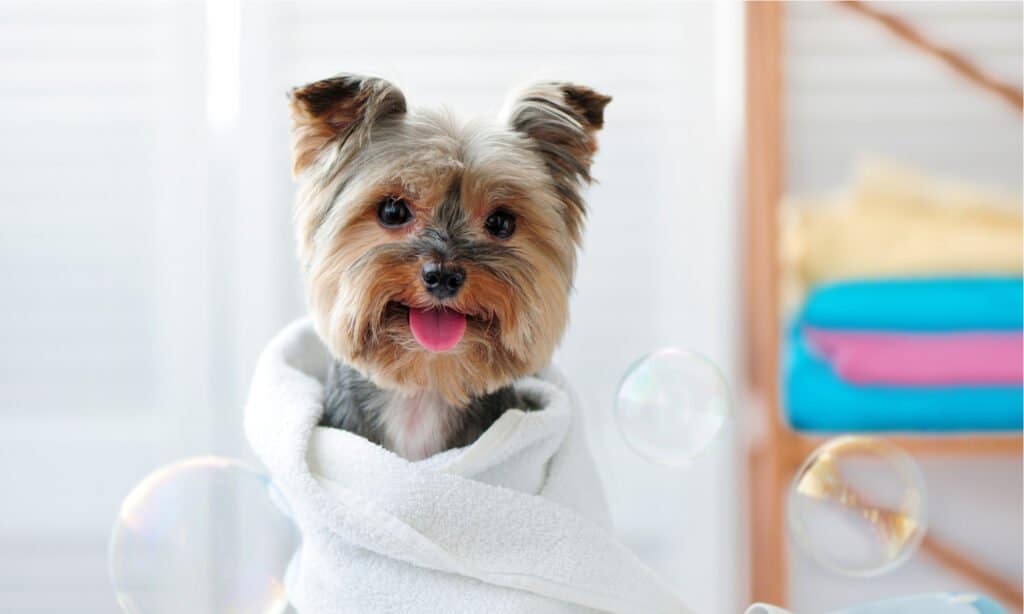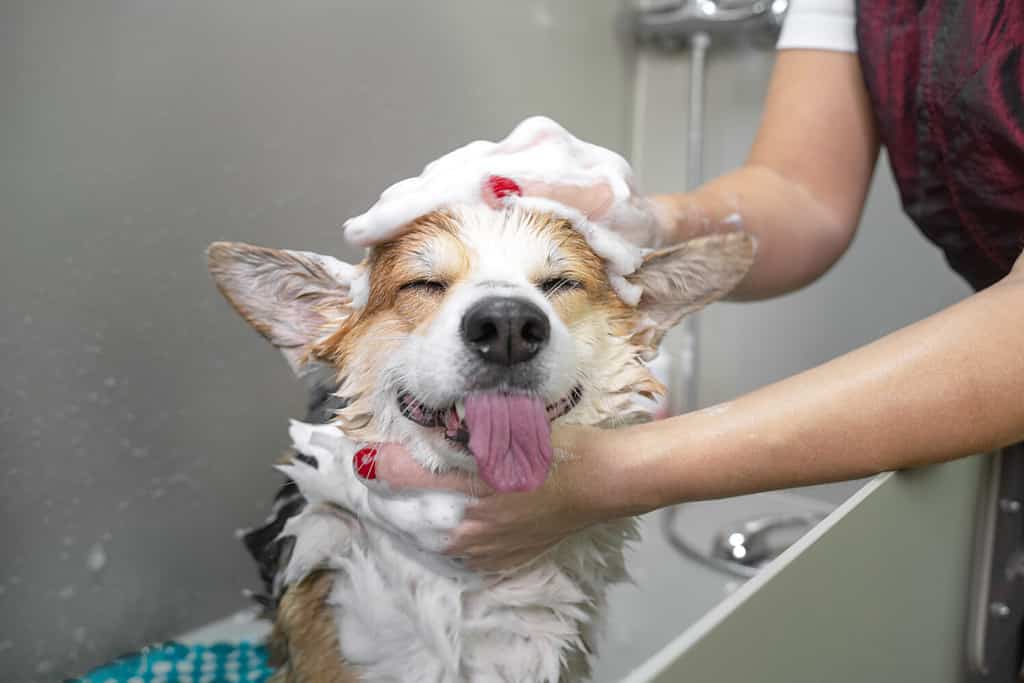Humans have been breeding dogs for thousands of years, so the species varies considerably in coat type, activity level, and so much more. This means that how often you need to bathe your dog will also vary.
In general, long-haired dogs should be bathed every three to six weeks, and short-haired dogs should get a bath once every one to three months. Skin and coat health, activity level, and lifestyle also impact how often you need to bathe your dog.
In this article, we’ll discuss how often is ideal to bathe your dog, why you shouldn’t bathe them too frequently, and more.
How Often Should You Bathe Your Dog?

Depending on their breed and lifestyle, your dog may need to be bathed anywhere from every three weeks to every three months.
©iStock.com/DuxX
The amount of baths your dog needs will depend on their breed, fur type, and lifestyle. It can range from once every few weeks to just a few times a year.
Usually, dogs who are more active or mischievous and those with denser or longer fur will need to be bathed most often.
If you frequently go for hikes, swims, or jump in puddles with your pup, they’ll need more baths than the average dog. Dogs who spend most of their time indoors and stay clean on walks will need fewer baths because they won’t be nearly as dirty!
Short-Haired Dogs vs Long-Haired Dogs
Most short-haired dogs need baths only as necessary, such as if they get into something messy, have a health problem, or begin to develop a smell. You’ll typically know when it’s time to clean them up!
But if it’s been over three months since your dog’s last bath, you should get them in the tub!
Long-haired dogs tend to get things caught in their fur and just get messy easier. They typically need baths every three to six weeks depending on breed and lifestyle, but may need more frequent baths if they’re the outdoorsy, trouble-making sort!
Fur texture also matters as those with thinner straight or wavy hair will typically need less frequent bathing than those with dense, curly coats.
Dogs with Skin Conditions
Dogs with skin conditions may need more frequent bathing than healthy dogs. Sometimes, your vet will recommend a special shampoo to take care of your dog’s health problems. Conditions that require frequent bathing include skin infections, parasites, and allergies.
Follow your veterinarian’s advice when it comes to how often to bathe your dog and whether any special shampoos or medications are needed.
Should I Bathe my Dog Less in the Winter?

It can sometimes be more difficult to bathe dogs in the winter months.
©Eudyptula/Shutterstock.com
Some people get nervous about bathing their dog in the winter since it’s cold. It is true that you don’t want to let your wet pup out in the snow.
But, you can bathe your dog just as often in winter so long as you dry their coat thoroughly before letting them outside. If they don’t like the blow dryer, towel dry them and then keep them in the warm house until they’re no longer wet.
Your dog may not need frequent baths in the winter if they aren’t doing as many outdoor activities and thus aren’t getting as dirty.
It can also be challenging to bathe dogs in the winter, particularly if you can’t get them into the tub. In cold climates, hosing your dog off outside just isn’t feasible.
In these cases, you may choose to space out their baths longer if that’s possible for your dog. You can also try training them to get into the tub, using a bathing station at your local pet store, or having a dog groomer bathe your pup.
Can You Bathe a Dog Too Much?

Frequent bathing can harm a dog’s coat and skin.
©Danielle W Press/Shutterstock.com
Bathing your dog too much can dry out their skin. This can also cause them to have more dander or flaky skin.
Some people bathe their dogs frequently due to their own dog allergies, and this can be counterproductive due to the extra dander produced when the skin is too dry.
Frequent baths can also damage a dog’s coat and strip away the natural oils necessary to maintain skin and coat health.
Daily baths are unnecessary for a dog unless they have a health problem warranting it. If your pup always gets dirty in one area, you may be able to clean just that place. For instance, muddy feet or a dirty bum don’t require a full-body bath every time.
Some breeds can be bathed weekly, but it doesn’t tend to be ideal and may still cause dry skin. Using a dog conditioner or reducing the frequency of baths can help.
Brushing can be a good substitute for frequent bathing as well, especially if your pup is short-haired and just has some dry debris like dirt in their coat.
Do Dogs Enjoy Baths? Why Does my Dog Hate the Tub?

Some dogs enjoy baths more than others, but training can help make the experience better for them.
©Kasefoto/Shutterstock.com
Whether or not your dog enjoys baths will depend on many factors, including breed, personality, training, past experiences, and more.
Breeds like Labradors and Poodles were bred to hunt waterfowl; therefore, they are more likely to enjoy the water.
If your dog dislikes baths, it may be a personality trait. Or, they’ve had bad experiences in the past or haven’t been trained to accept bath time.
While some dogs will never enjoy baths, they should be taught to tolerate them, and baths should be as positive of an experience as possible.
Helping Your Dog Enjoy Bath Time
Below are some ways to help make bath time more fun for your dog.
- Check the water temperature. Just like humans, dogs don’t want a burning hot or ice-cold bath! Make sure the water feels comfortable to your hand first.
- Running water can be scary. Some dogs prefer you fill the tub with a couple of inches of water and use a cup to pour it onto their coat rather than spraying them with a showerhead or hose.
- Offer treats–lick mats are perfect for bath time! They even sell lick mats that stick to the side of the tub, and they’re a great distraction for a nervous pup.
- Introduce the tub slowly. It can be overwhelming for a dog, so take things step by step. Start by teaching them to accept handling by petting their bodies, including their bellies, ears, and other areas you’ll need to wash. Then, train them just to go near the tub, next to climb inside a dry tub, and finally, enter the tub with water.
- Never punish your dog for disliking the bath. Instead, focus on making it the best experience possible for them, and extend some understanding to your pup if they dislike the process. Remember that they’re not trying to misbehave on purpose; they’re just scared!
How to Bathe Your Dog

The most difficult part of bathing your dog is typically getting them to accept going into the water!
©Masarik/Shutterstock.com
- Purchase a dog shampoo. Human shampoos and dish soap will dry out a dog’s skin. They’re typically okay in a pinch, such as when giving a new dog a flea bath, but not for repeated use.
- Desensitize them slowly if possible. Sometimes, your dog will need an immediate bath. But if they don’t, try to introduce the process slowly and give them time to learn.
- Wet their coat thoroughly. You can use a shower head or hose to spray them down, or fill the bathtub with a bit of water and scoop it onto your dog’s body.
- Lather shampoo in your hands, then wash your dog’s entire body down to the skin. Remember to wash their feet, tail, belly, armpits, and any wrinkles in their skin.
- Rinse well. You don’t want to leave any soap behind, as this can irritate your dog’s skin. Rubbing circles in their coat as you rinse can help to lather any leftover soap, making it more noticeable.
- Use dog conditioner if desired or needed. Conditioner is great for dogs who get frequent baths, as it reintroduces some oil to the coat.
You can also bring your dog to a professional groomer for their bath. Since most long-haired dogs require professional grooming anyway, this can be a simple way to manage their hygiene.
However, it’s still good to desensitize your dog to the process at home if you can. This will make your groomer’s job easier and ensure they can bathe your dog successfully!
Thank you for reading! If you have feedback on this post, please contact the AZ Animals editorial team.
The photo featured at the top of this post is © iStock.com/fotoedu
Ready to discover the top 10 cutest dog breeds in the entire world?
How about the fastest dogs, the largest dogs and those that are -- quite frankly -- just the kindest dogs on the planet? Each day, AZ Animals sends out lists just like this to our thousands of email subscribers. And the best part? It's FREE. Join today by entering your email below.
Thank you for reading! Have some feedback for us? Contact the AZ Animals editorial team.







